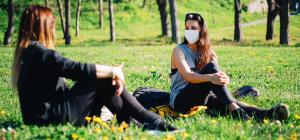
Accessibility for persons with disabilities during the COVID-19 pandemic

Financial challenges, loss of jobs, inequity in accessing medical care and food, and exclusion in policies, have disproportionately impacted the mental and physical health of persons with disabilities during the COVID-19 pandemic, including for those in Canada. As physical distancing and hand hygiene have been important in preventing the transmission of COVID-19, accessibility in the physical environment can help keep persons with disabilities safe during the pandemic and can bolster their independence.
Almost one-quarter of Canadians self-identify as having a physical disability related to mobility, vision, or hearing in a survey published by the Angus Reid Institute in 2019. Disabilities can be physical and visible, and can also be sensory, cognitive, or related to mental health, and not always visible. Disabilities can happen at any time in a person’s life, and can be permanent, temporary, or episodic and vary in severity. Whether or not an environment is accessible is considered by three in ten Canadians when deciding to go to a particular destination. The COVID-19 pandemic may present more challenges in the environment for individuals with disabilities.1-2
How the environment affects the health and safety of people with disabilities during the pandemic
Physical accessibility
Prior to the COVID-19 pandemic, the design of existing facilities might already pose challenges to those with accessibility issues in public spaces. The pandemic brought additional obstacles to their safety and independence. For instance, heights of sinks, soap and towel or hand sanitizer dispensers placed too high for people with limited mobility could compromise their hand hygiene.
Difficulties with obtaining essential supplies and navigating grocery stores is a common issue raised during the pandemic. Blind persons cannot see cues for physical distancing in store aisles or know there are plastic barriers placed at service counters. The lack of awareness in staff can result in customers with invisible disabilities being admonished for not distancing properly and not receiving personal assistance with locating groceries. Spaces may not be large enough for wheelchair users to distance from others or to turn around. Lack of curb ramps or uneven ground surfaces, standing in long queues to pay for food or reaching for food on shelves are physically challenging for people with limited mobility. Blind persons may have problems locating food placed in open spaces or in the middle of aisles. 3-5
These challenges point to a need for improved accessibility in the design of environments. For example, supermarkets could provide larger and high contrast signs as cues or staff to help people with limited vision, or chairs in long lines to aide people with limited strength and mobility. Web apps may also provide auditory distancing cues. Dedicated shopping hours for the elderly could include a those who are disabled, and/or to ensure store assistance is provided to blind people. Disability awareness for staff and the public can help with understanding that some with cognitive disabilities find it difficult to adhere to or even understand prevention measures.
Policies can also hinder people from getting the supplies they need. In the United Kingdom, online food delivery options were designated for people who were extremely vulnerable and filled up quickly. People with disabilities who did not fall into this category and who lost their regular personal support had to obtain supplies on their own. More inclusive policies such as providing delivery services to people with a wider range of disabilities would ease the procurement of essential goods.
When infrastructure such as accessible transportation and businesses close down, it can be more difficult for people with disabilities to obtain supplies. People in China were caught off guard with inadequate food, medicine, and hygiene products during the initial pandemic lockdown. The national emergency response plan did not consider their needs for medication or assistive devices. Including needs of people with disabilities in emergency plans is crucial to address the many challenges faced during a pandemic or disaster.
As the pandemic has resulted in many businesses closing their washrooms to the public, people have had trouble finding available public toilets. The unavailability of washrooms is especially difficult for people with illnesses or who travel around for work, such as delivery drivers. Wheelchair users or people with limited mobility need accessible washrooms which may be even harder to locate during the pandemic. For businesses concerned about opening public washrooms, some considerations for both washroom operators and visitors can mitigate transmission risk of COVID-19 in these facilities.6
High touch surfaces
While we now know that COVID-19 is primarily transmitted via droplets and aerosols, it is still possible for the virus to be transmitted through fomites. Evidence on the risk of transmission via fomites is insufficient and more research is needed to understand the role of fomites in COVID-19 transmission.
High touch surfaces have been of concern as the deaf-blind community communicate through touch, or people with limited mobility may need surfaces for support. Handrails including those on public transport, door handles, grab bars in washrooms, and the lack of automatic doors and sensor-based features in public washrooms could result in prolonged contact with surfaces.7-8 Maintaining hand hygiene can help prevent COVID-19 transmission in people who rely on touching surfaces frequently.
Close proximity to others
For those needing personal support from caregivers, close contact with others increases their exposure risk to the COVID-19 virus. People who have developmental disabilities or elderly who have dementia may not understand how to physically distance from others, wash their hands or wear masks effectively.
Canada’s long-term care facilities were hit hard by the COVID-19 pandemic. Overcrowded, communal living conditions and close proximity with care support workers contributed to high infection and fatality rates in resident populations. However, recent vaccination of long-term residents has been associated with a decrease in fatality rates. 9-10
The use of technology to convey COVID-19 health information to people with disabilities
As COVID-19 information emerged throughout the pandemic, the lack of accessible formats in digital information has made it difficult for people with vision or hearing disabilities to obtain updates about the COVID-19 virus. Accessible formats, can make health information easier to understand. Easy Read, used in the United Kingdom, is a method of presenting text in shorter sentences and larger print for people with developmental disabilities to understand. Close captioning and sign language interpreters can aide people with hearing disabilities. Tactile letters or braille on signage and wayfinding apps are used by people with visual disabilities. Technology could hold the potential to show signage and amenities for COVID-19 safety.
In contrast, technology may not work in all situations as people with cognitive disabilities may need to rely on others to provide information. Some may not have internet access at home or accessible formats may not be available in all countries. When technology is not available or not suitable, communities need to think about how to best deliver information to those who cannot access or understand digital or traditional media.
Further research
The challenges described above have been experienced by people with disabilities from different geographical areas.4,5,8,12 Yet it is not yet clear if earlier research findings concerning accessibility considerations in the context of the COVID-19 pandemic have resulted in practice and/or policy changes. Recovery from the COVID-19 pandemic presents an opportunity to address challenges experienced by people with disabilities. As research becomes more targeted to serve the needs of people with specific accessibility needs, so too can policies on medical and rehabilitation services, assistive devices and technology, employment, education, transportation, and communications. 11-12
Summary
COVID-19 has deeply disrupted society and has disproportionately affected people with disabilities in multiple ways which is particularly challenging to persons with disabilities for whom constancy is key. Increased poverty, lack of access to health services, inability to obtain essential needs such as food and medicine, and environmental accessibility that compromises safety and healthcare are just some of the” layers of vulnerability”. 13
In emergency or disaster response planning, inclusion of people with disabilities can facilitate safer evacuation for them during natural and/or large-scale disasters such as wildfires, hurricanes, floods, earthquakes, industrial disasters. Implementing accessibility in evacuation plans, such as ensuring there are smoke protected refuge areas with adequate space, clear signs to accessible ground floor exits, and evacuation equipment can be vital in keeping people safe in emergencies . Involving disability rights groups and community members with disabilities in initial planning stages and disaster drills can contribute to an accessibility lens. Inclusion should not only include physical disabilities, but also address sight or hearing loss, cognitive and developmental disabilities, and aging. Accessibility in the design of public amenities can provide infrastructure that is ready in the event of another infectious disease outbreak or disaster.
Facilitating accessibility in the physical environment can support safety when disasters hit and is less costly when implemented at the beginning of a build or retrofit project. ’Easy fixes’ can involve adjusting the height of handwashing supplies lower for wheelchair users or providing additional cues in public spaces for physical distancing. Longer-term solutions, such as retrofitting building features for accessibility (e.g., widening doorways or building universal washrooms) require more planning, allocation of resources, and will take time to put in place.
Resources for stakeholders
- Government of Canada, COVID-19 and People with Disabilities in Canada (Last updated Feb 2021)
- World Health Organization, Disability Considerations during the COVID-19 Outbreak, March 2020
- United Nations, Policy Brief – A Disability-Inclusive Response to COVID-19, May 2020
References
- Angus Reid Institute. Accessibility: a source of future anxiety and a significant consideration for Canadian consumers today. Vancouver, BC: Angus Reid Institute; 2019. Available from: https://angusreid.org/accessibility-future-anxiety-rhf.
- Human Resources and Skills Development Canada. Federal disability reference guide. Ottawa, ON: Government of Canada; 2013 Aug. Available from: https://www.canada.ca/en/employment-social-development/programs/disability/arc/reference-guide.html#h2.3-h3.1.
- Inclusion London. Abandoned, forgotten and ignored. The impact of the coronavirus pandemic on Disabled people. London, UK: Inclusion London; 2020 Jun. Available from: https://www.inclusionlondon.org.uk/wp-content/uploads/2020/06/Abandoned-Forgotten-and-Ignored-Final-1.pdf.
- International Disability Alliance. Voices of people during COVID-19 outbreak series. “COVID-19 in Ontario (Canada): grocery shopping has never been more difficult for persons with disabilities. New York, NY: International Disability Alliance; 2020 May 21. Available from: https://www.internationaldisabilityalliance.org/covid19-canada.
- Eskytė I, Lawson A, Orchard M, Andrews E. Out on the streets - Crisis, opportunity and disabled people in the era of Covid-19: reflections from the UK. Alter. 2020;14(4):329-36. Available from: https://doi.org/10.1016/j.alter.2020.07.004.
- Brown A. The pandemic has closed public restrooms, and many have nowhere to go. PEW Trust. 2020 Jul 23. Available from: https://www.pewtrusts.org/en/research-and-analysis/blogs/stateline/2020/07/23/the-pandemic-has-closed-public-restrooms-and-many-have-nowhere-to-go.
- World Health Organization. Disability considerations during the COVID-19 outbreak. Geneva, Switzerland: WHO; 2020 Mar. Available from: https://www.who.int/docs/default-source/documents/disability/covid-19-disability-briefing.pdf.
- Goggin G, Ellis K. Disability, communication, and life itself in the COVID-19 pandemic. Health Sociol Rev. 2020 May;29(2):168-76. Available from: https://doi.org/10.1080/14461242.2020.1784020.
- Webster P. COVID-19 highlights Canada’s care home crisis. The Lancet. 2021;397(10270):183. Available from: https://doi.org/10.1016/S0140-6736(21)00083-0.
- Vieira P. Covid-19 slammed Canada’s nursing homes. Now deaths are way down. 2021 Mar 12. Available from: https://www.wsj.com/articles/covid-19-slammed-canadas-nursing-homes-now-deaths-are-way-down-11615571085.
- Lebrasseur A, Fortin-Bédard N, Lettre J, Bussières E-L, Best K, Boucher N, et al. Impact of COVID-19 on people with physical disabilities: a rapid review. Disability Health J. 2021;14(1):101014. Available from: https://doi.org/10.1016/j.dhjo.2020.101014.
- Jalali M, Shahabi S, Bagheri Lankarani K, Kamali M, Mojgani P. COVID-19 and disabled people: perspectives from Iran. Disabil Soc. 2020;35(5):844-7. Available from: https://doi.org/10.1080/09687599.2020.1754165.
- Jesus TS, Kamalakannan S, Bhattacharjya S, Bogdanova Y, Arango-Lasprilla JC, Bentley J, et al. People with disabilities and other forms of vulnerability to the COVID-19 pandemic: study protocol for a scoping review and thematic analysis. Arch Rehabil Res Clin Transl. 2020 Dec;2(4):100079. Available from: https://doi.org/10.1016/j.arrct.2020.100079.







